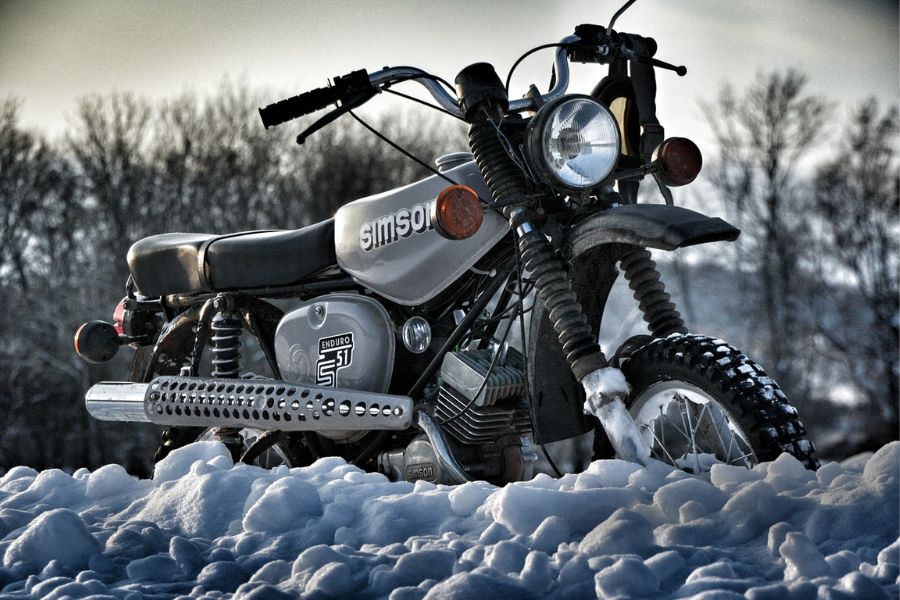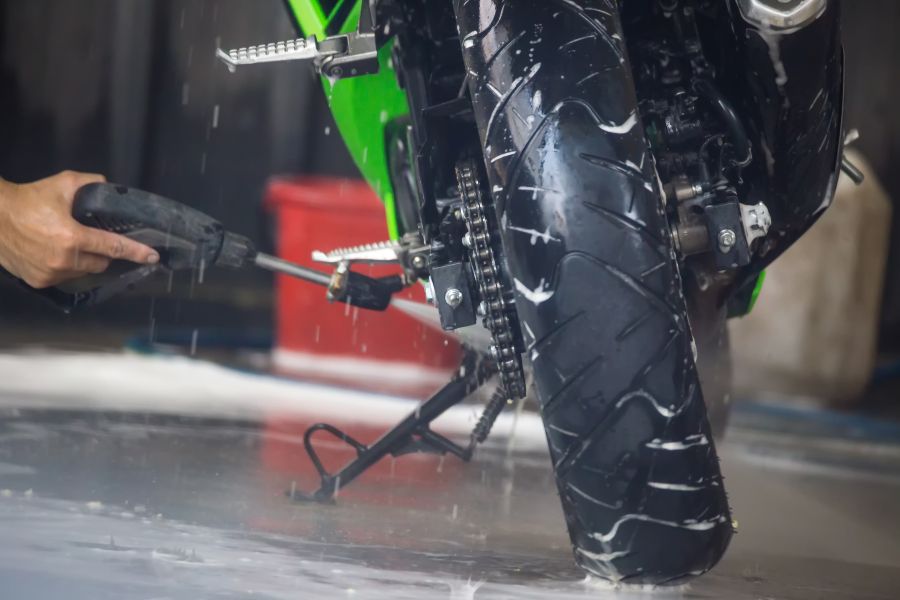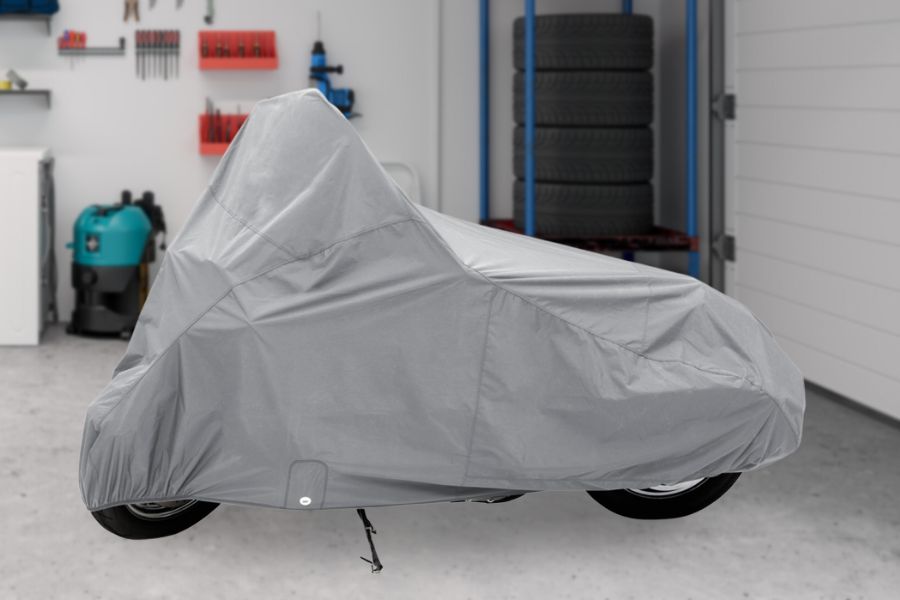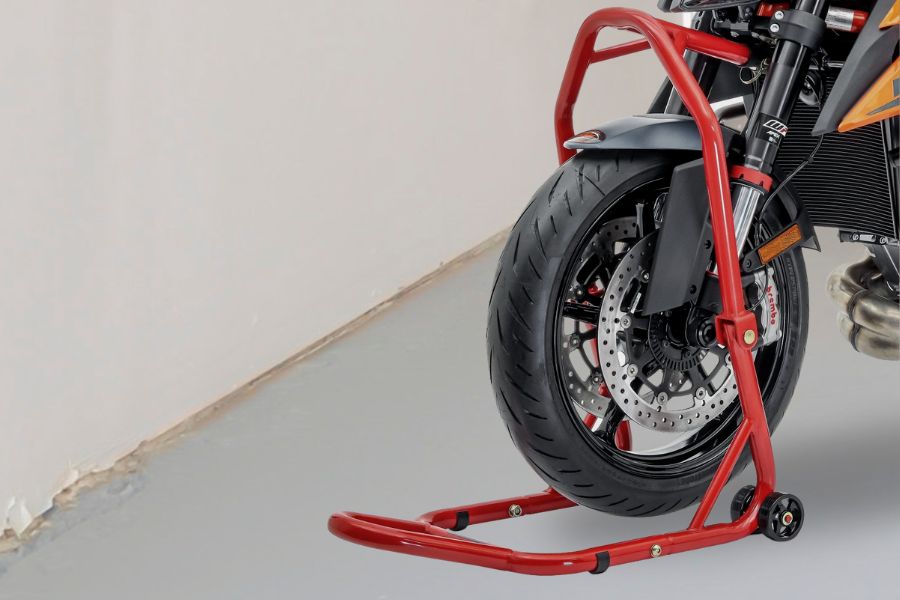A Detailed Guide to Motorcycle Winter Storage

Winter is beautiful, but it can be a nightmare for motorcycle owners. It signifies the end of the riding season.
Unless riders equip their motorcycle with winter tires, they must face the unfortunate reality of putting their beloved bikes away until warmer weather returns.
However, proper winter motorcycle storage is crucial to ensure your bike remains in top condition.
What do you need to do before storing a motorcycle? What are the dos and don’ts?
If you are curious about these, you are in the right place.
This article will explore how to prepare your motorbike for spring and why this is such a big deal.
Ready? Let’s demystify this.
Best Practices for Motorcycle Winter Storage
Before putting your bike away for a long winter, it requires an oil change, coolant fluids, and a general check. But this is only a fragment of bike storage must-dos. Below, we’ve highlighted other best practices.
Clean Your Motorcycle
Give your motorcycle a thorough cleaning or a good wash before storing it. Dirt, debris, and bugs left on your bike can lead to corrosion and rust.

Pro tip: use mild soap and water to clean your motorcycle, and leave it to dry completely before storing it.
Change the Oil and Filter
Old oil can contain contaminants that can eventually corrode or damage your engine during storage. Refilling with fresh oil before motorcycle storage is advisable as it prevents corrosion. Besides, it ensures your motorcycle is ready to ride when the weather warms up.
Pro tip: Run the engine till it reaches operating temperature after changing the oil. That way, the fresh oil will coat the engine.
Top-Off Fluids
When a fuel tank sits in storage for long and traps air, it risks your fuel system. Thus, topping off your motorcycle’s coolant, brake, and hydraulic fluid before storage protects your fuel system.
Fuel Stabilization
The truth is fuel left in your motorcycle’s tank can degrade over time. And this leads to clogged fuel injectors, carburetors, or engine damage.
How can you prevent fuel degradation? By adding a fuel stabilizer to your motorcycle’s tank.
Pro tip: Ride your motorbike till the gas tank is almost empty. Then add the fuel stabilizer before you refill with fresh gas at the gas station. The stabilizer will circulate when you eventually ride the bike home for storage.
Battery Maintenance
Disconnect the battery from your motorcycle and store it in a cool, dry place. Check the battery’s charge monthly and recharge it if necessary to keep it from dying or damaging during storage.
Tire Pressure
Overinflated or underinflated tires can damage your motorcycle’s rims and tires when stagnant for a long period. Before storing your motorcycle, check the front and rear tire pressure and inflate it to the recommended level.
Store in a Cool, Dry Place
Moisture can cause significant damage to your motorcycle during storage, leading to rust and corrosion. Hence, store your motorbike in a cool, dry place away from direct sunlight and moisture.
Cover Your Motorcycle
Finally, use a breathable motorcycle cover to protect your motorcycle from dust and debris during storage. The cover should be lightweight and breathable to prevent moisture buildup.

Choosing the Right Storage Location
Several factors come into play when choosing the location for your motorcycle storage. First and foremost, security should be your top priority.
You want to ensure that your motorcycle is stored in a secure location that is safe from theft or damage. A well-lit area with security cameras and a secure gated garage or storage unit that requires a security code or key card can offer the best protection. You can’t be too careful!
Temperature and humidity are also crucial when choosing a storage location. Moisture can cause significant damage to your motorcycle, leading to corrosion. Therefore, it’s best to select a consistent temperature environment for storage. You can use an insulated garage or storage unit to regulate the temperature and humidity levels.
Additionally, consider accessibility. Ensure the storage is easily accessible to check your bike and perform the necessary maintenance.
Another essential factor to consider is ventilation. Proper ventilation prevents the buildup of fumes and moisture, which can damage your motorcycle. So, select a location with adequate ventilation.
Lastly, consider the distance of the storage location from your home or workplace. You want to keep your motorcycle close enough for convenience.
Checking on your motorcycle during storage
Storing your bike is incredible. But if you fail to check it during storage, it defeats the purpose of preserving it in the first place.
Hence the need to keep an eye on your motorcycle in storage.
The first thing you should do is inspect your motorcycle’s battery. Cold weather can drain your battery quickly, leaving it dead and damaged. Check your battery often to ensure it’s fully charged and adequately connected.
Next, you should monitor the tires’ air pressure. Winter may cause the air pressure in your tires to drop, damaging your tires and rims. Ensure that your tires have the proper air pressure and, if necessary, add more air to them.
Also, run your motorcycle often to keep it in good condition. Start the engine and let it run for a few minutes to circulate the oil. This simple act prevents rust from forming on metal parts.
Ultimately, clean your motorcycle regularly during storage to wade off dirt and debris. You can also use a protective wax or spray to protect the paint and chrome from rust and corrosion.
Common Mistakes to Avoid While Storing Your Motorcycle
Here are some common mistakes to avoid while storing your motorcycle for winter.
Not Preparing Your Motorcycle for Storage
Most riders make the common mistake of not preparing their motorcycle for storage. Before storing your motorbike, clean it thoroughly, change the engine oil and filter, and add fogging oil. Neglecting these tasks can lead to corrosion, rust, and fuel degradation.
Leaving the Battery Connected
Another common mistake is leaving the battery connected during storage. Batteries left connected can drain quickly, causing damage or failure. So, disconnect the battery, remove it from the motorcycle, and store it in a cool, dry place.
Storing Your Motorcycle in a Humid Area
Moisture buildup is bad news for motorbikes. Humid storage will do just that to your bike. Choose a cool, dry location to keep it away from moisture and direct sunlight. You may also use a dehumidifier to reduce the humidity levels.
Not Covering Your Motorcycle
Leaving your motorcycle uncovered can lead to dust and debris buildup, damaging the paint and chrome. Use a breathable motorcycle cover to protect your motorcycle during storage. Avoid using plastic or non-breathable covers. They can trap moisture and lead to corrosion.
Storing Your Motorcycle on its Kickstand
Keeping your motorcycle on its kickstand for an extended period can damage it and cause flat spots. We suggest you use a motorcycle stand or blocks to keep your motorcycle upright during storage.

Not Starting Your Motorcycle During Storage
While starting your motorcycle daily during storage is unnecessary, neglecting it can lead to rust and corrosion. Start your bike at least once in a couple of weeks and let it run for a few minutes.
DIY vs. Professional Winter Storage
You’ve got two motorcycle winter storage options: DIY and professional storage. Which one is the best? Well, that’s only a matter of choice and needs.
DIY Motorcycle Storage
DIY storage involves storing your motorcycle in a location you control, such as a garage or shed. This option is often cheaper than professional storage and gives you full control over your motorcycle’s storage conditions.
Benefits of DIY Motorcycle Storage
- Cost-effective: DIY storage is often the most cost-effective option, as you won’t have to pay professional storage fees.
- Complete control: With DIY storage, you have full control over your motorcycle’s storage conditions, including temperature, humidity, and other factors.
- Convenient: DIY storage allows you to access your motorcycle whenever you need it without coordinating with a storage facility.
Drawbacks of DIY Motorcycle Storage
- Limited space: Unless you have a large garage or storage area, you may not have enough space to store your motorcycle correctly.
- Lack of security: DIY storage locations may leave your motorcycle at risk of theft or damage.
- No insurance: If your motorcycle is damaged or stolen while in DIY storage, insurance may not cover you.
Professional Motorcycle Storage
Professional motorcycle storage involves storing your bike in a storage facility specifically for motorcycles. These facilities offer climate-controlled environments, security measures, and other amenities to protect your bike during winter.
Benefits of Professional Motorcycle Storage
- Climate-controlled environment: Professional storage facilities offer climate-controlled environments to shield your bike from moisture, rust, and corrosion.
- Security: Storage facilities offer 24/7 security measures to protect your motorcycle from theft and damage.
- Insurance: They often provide insurance coverage for your motorcycle while in storage, giving you peace of mind.
Drawbacks of Professional Motorcycle Storage
- Cost: Professional storage facilities are more expensive than DIY storage, with fees ranging from a few hundred to several thousand dollars.
- Inconvenient: You may have to coordinate with the storage facility to access your motorcycle. This could be inconvenient if you need it on short notice.
- Lack of control: You may not completely control your motorcycle’s storage conditions. Facility set parameters for temperature, humidity, and other factors.
What Next?
Storing your bike during the winter months helps you avoid road hazards and other risks associated with winter riding.
So, if you’re a motorcycle rider, don’t take any chances with your beloved bike this winter. Take time to prepare it properly and store it safely to ensure it’s ready to ride again come springtime.
In no time, you will be ready to enjoy the freedom and excitement that only two wheels can provide.

